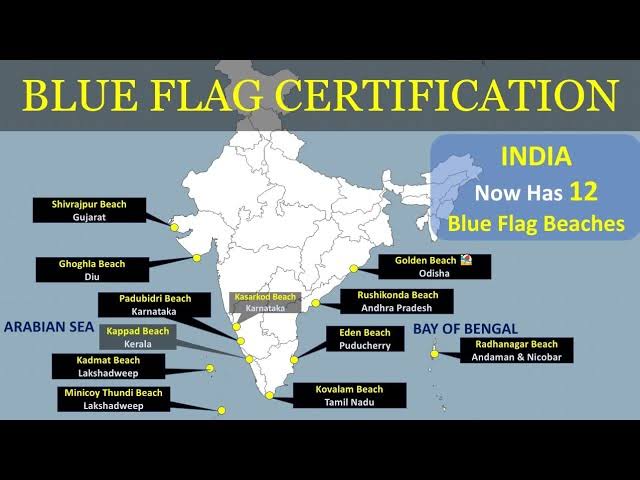
• The Blue Flag Certification is given out by the Foundation for Environmental Education (FEE), which is a non-profit group.
• In 1985, France was the first country to start the Blue Flag Programme. The FEE heard about it in 1987. Then it became the Blue Flag of Europe.
• When South Africa joined the scheme in 2001, it became the first country outside of Europe to join. At that time, the program’s name was changed to “International Blue Flag.”
At this time, the FEE got its current name. Before this, its name included the word “European,” but now it doesn’t.
• To get the Blue Flag certificate, you must meet a long list of strict requirements or standards. The criteria are linked to the environment, education, accessibility, and safety. There are 33 factors in all.
• The programme encourages sustainable development in freshwater and marine areas by focusing on four key criteria: water quality, environmental management, environmental education, and safety.
• The certification is given to beaches, marinas (small ports or harbours for pleasure yachts or boats), and providers of sustainable boat tourism in FEE member countries. The Sustainable Development Goals are helped by Blue Flag.
• The Blue Flag is an eco-label, and beaches with it should have clean, safe water for swimming and basic facilities for tourists.
Those who have been given the “blue flag” for beaches or boating tourism are allowed to use the blue flag logo. This is only given to local governments or business operators in member countries.
• Blue Flag also fights against inequality, disparity, unemployment, depletion of natural resources, risks to health and the environment, pollution, and the general degradation of the environment.
• The Blue Flag is given by an international panel of experts from the United Nations Environment Programme (UNEP), the United Nations World Tourism Organisation (UNWTO), the Foundation for Environmental Education (FEE) in Denmark, and the International Union for the Conservation of Nature (IUCN).
• There are more than 4,000 beaches with the blue flag certification around the world. Spain has the most beaches with this certification.
Table of Contents
Foundation for Environmental Education (FEE)
It was started in 1981 as the Foundation for Environmental Education in Europe (FEEE) and has its headquarters in Copenhagen, Denmark.
It is made up of 77 countries at the moment. Among its other projects are Green Key, Eco Schools, Young Reporters for the Environment, Learning about Forests, and the Global Forest Fund.
Blue Flag Beaches in India
Puri beach on the Konark coast of Odisha is not only the first beach in India to get the Blue Flag approval, but it is also the first beach in Asia to do so.
As of October 2022, the approval has been given to 12 beaches in India. They are: 1. Golden Beach, Odisha
2. Shivrajpur Beach – Gujarat
3. Kappad Beach – Kerala
4. Ghoghla Beach – Diu
5. Radhanagar Beach – Andaman and Nicobar
6. Kasarkod Beach – Karnataka
7. Padubidri Beach – Karnataka
8. Rushikonda Beach – Andhra Pradesh
9. Kovalam Beach – Tamil Nadu
10. Eden Beach – Puducherry
11. Minicoy Thundi Beach in Lakshadweep, India
12. Kadmat Beach in Lakshadweep
I-AM- SAVING-MY-BEACH
On World Environment Day in June 2018, India launched its beach cleaning campaign, I-AM-SAVING-MY-BEACH, at the same time in 13 coastal states. After that, the ministry’s highly regarded Beach Environment and Aesthetics Management Services (BEAMS) programme was put into place.
BEAMS stands for Beach Environment and Aesthetics Management Services.
• In order to achieve “Sustainable Development” in India’s coastal areas, the Ministry of Environment, Forests, and Climate Change (MoEF&CC) started a very well-known programme called BEAMS.
It is part of the Integrated coastal zone management (ICZM) approach that the Ministry of Environment, Forests, and Climate Change (MoEF&CC) is using to help the coastal regions of India develop in a sustainable way. The main goal is to protect and preserve the pristine coastal and marine ecosystems by managing the resources as a whole. This was done to get the internationally recognised and highly sought-after “Blue Flag” eco-label.
The goal of the BEAMS programme is to:
• Make coastal seas less dirty.
• Help beach facilities grow in a way that is good for the environment.
• Protect and keep natural resources and coastal areas in good shape.
• Ask local governments and other important people to work hard to keep beaches clean, safe, and healthy for beachgoers in line with the rules and surroundings of the coast.















![UPSC CSE Topper Mains Answer [Part 1] images-2023-06-17T191749.185](https://iasbio.com/wp-content/uploads/2023/06/images-2023-06-17T191749.185-150x150.jpeg)
